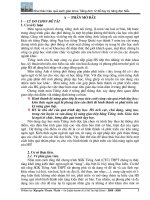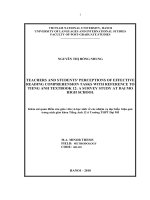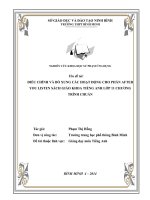Sách giáo khoa tiếng anh 12 phần 9
Bạn đang xem bản rút gọn của tài liệu. Xem và tải ngay bản đầy đủ của tài liệu tại đây (418.69 KB, 11 trang )
Exercise 2. Put a/an, the or φ in each space to complete the following
sentences.
1. We went by
2.
train to the west of England.
people who live in
Scotland are called
Scots.
3.
Columbus was one of
Atlantic.
4. Davis learned to play
university.
5. Did you read
6. Is that
first people to cross
violin when he was at
book I lent you
present Bill gave you for
last week?
Christmas?
7. _____ computer has already changed ______ our lives
dramatically.
8. There was
street.
9. I need
10.
accident yesterday at
time to think about
little knowledge is
corner of
offer you gave me.
dangerous thing.
TEST YOURSELF C
I.
Listening (2.5 points)
Listen to a passage making predictions about the second half of the
twenty-first century. Choose the best answer from the options A, B or C.
1. The world’s population will increase from 6 billion to 10 billion,
mostly in
.
A. America and Asia
B. Africa, Asia and Latin America
C. Africa, Asia and America
2. The earth’s climate will become warmer, which will create
.
A. droughts and famine in Africa
B. droughts and famine in southern Europe
C. Both A and B
3. In the second half of the 21st century,
.
A. the world’s supplies of petroleum will run out
B. people can’t produce electric vehicles
C. we’ll go on using our normal cars
4. With the help of new technology,
.
A. people will communicate easily in the same place
B. people won’t need to be in the same place to communicate
C. people can use computers and videophones at home
5. Patterns of work may change. People
A. won’t need to go to banks, offices
B. won’t have to go to schools, universities or shops any more
C. Both A and B
.
II.
Reading (2.5 points)
Read the passage and decide whether the following statements are true
(T) or false (F).
People used to know more or less how their children would live. Now
things are changing so quickly that we don’t even know what our own
lives will be like in a few years. What follows is not science fiction.
It’s how experts see the future.
You’re daydreaming behind the wheel of your car, but that’s OK. You
have it on automatic pilot, and with its high-tech computers and
cameras, your car “knows” how to get you home safely.
What’s for lunch? In the old days, you used to stop off to buy a
hamburger or pizza. Now you use your diagnostic machine to find out
which foods your body needs. You find out you need more vegetables
and less fat. Your food-preparation machine makes you a salad.
After lunch, you go down the hall to your home office. Here you have
everything you need for doing your work. Thanks to your information
screen and your new computer, you almost never go into the office
any more. The information screen shows an urgent message from a
co- worker in Brazil. You set the screen to translate Portuguese into
English, then you read and reply to the message.
T F
1. The experts who write science fiction think about our
own lives in the future.
2. You will be able to get home safely by car because you bring
your own high-tech computers and cameras with you.
3. For lunch, your special machine will help you choose
proper foods and makes you a salad.
4. With the help of your information screen and new computer,
you will be able to work at home without going to the office.
5. When receiving an urgent message from someone in Brazil,
you will be able to translate it from Portuguese into English
yourself before reading and replying to the message.
III. Grammar (2.5 points)
A. Put a/an, the or no article (Ø) in each space to complete the
sentences. (1.5 points)
1. I must go to
2. Would you like
post office to buy some stamps.
apple?
3. Mr. and Mrs. Smith invited us to
4. Did Jane get
5. We took
dinner.
job she applied for?
taxi to the airport.
6. There are millions of stars in
space.
B. From each pair of sentences, make one sentence with Although or
Even though. (1 point)
1. Nam worked very hard. He didn’t pass the exam.
.
2. I was very tired. I couldn’t sleep.
.
3. She had all the necessary qualifications. She didn’t get the job.
.
4. The traffic was bad. We arrived on time.
.
IV. Writing (2.5 points)
In 150 words, write a passage about the changes in our lives in the
next 30 years. You should focus on the following areas:
●
People
●
Foods and water
●
Transportation
●
Communications
Unit
DESERTS
9
A. READING
Before you read
Work in pairs. Ask and answer the
following questions.
1. What do you know about deserts?
2. What kinds of plants and animals live
in a desert?
3. Name some of the countries which
have deserts.
●
While you read
Read the passage and do the tasks that follow.
Three great stretches of sandy desert almost circle the centre of
Australia. To the north of Nullabor Plain stretches the Great Victoria
Desert. In the west, the Gibbon, Great Sandy, and Tanami Deserts
comprise an enormous sandy area. North of Lake Eyre lies the
Simpson Desert, the last part of Australia to be explored.
The Simpson Desert lies between Lake Eyre in the south, the
Macdonnel Ranges in the north, the Mulligan and the Diamantina
Rivers in the east, and the Macumba and Finke Rivers in the west.
The first European entered the Simpson Desert in 1845. But the desert
remained a mystery until Madigan made an aerial survey in 1929.
He named the desert after Simpson, President of the South Australian
Branch of the Royal Geographical Society of Australia.
In 1936, Colson and an Australian Aborigine took camels across the
desert. They travelled along the border of South Australia and the
Northern Territory. Three years later Madigan led a scientific
expedition across the sand dunes on a more northerly route. Colson
and Madigan both travelled eastward across the Simpson Desert.
In the Simpson Desert there are different types of dunes. In the
western part of the desert, there is a network of short dunes, mostly
less than 10 metres high. Hummock grasses grow in loose sand on the
crest and spinifex grows in the corridors between dunes and on the
more stable slopes.
In the northern part of the desert, the dunes are parallel and separated
by corridors of low, open shrubland. Spinifex grows on the slopes of
the dunes. These dunes are deep red-brown, but the sand is pale in the
area where Queensland, South Australia and Northern Territory meet.
Dry salt lakes up to 70 kilometres long and 15 kilometres wide lie
between long dunes with crests 20 metres high.
Task 1. Give the Vietnamese equivalents to the following words or
phrases.
1. stretch
2. sandy
3. aerial survey
4. Royal Geographical Society
of Australia
5. Australian Aborigine
6. dune
7. sloping
8. steep
9. hummock
10. crest
11. spinifex
Task 2. Decide whether the statements are true (T) or false (F).
T F
1. According to the passage, there are three great deserts
in Australia.
2. The Simpson Desert is the largest one in Australia.
3. The desert was named after Simpson in 1929.
4. Colson and Madigan travelled across the Simpson Desert
in 1936.
5. There are more dunes in the western part of the desert.
6. Dry salt lakes are in the northern part of the desert.
Task 3. Answer the following questions.
1. What are the names of the three great stretches of sandy desert
which circle the centre of Australia?
2. Where is the Simpson Desert?
3. When did the first European enter the desert?
4. Who was Simpson?
5. How did E. A. Colson and an Australian Aborigine travel across the
desert?
6. What are the dunes like in the western and northern parts of the
desert?
7. How many kinds of grass grow in the Simpson Desert? What are
they?
After you read
Read this story and answer the questions that follow.
At a restaurant, a Vietnamese interpreter was having dinner with an
American businessman. It was a delicious dinner and both of them
enjoyed it enormously. Before the dinner was over, the interpreter
asked the American businessman: “What would you like for your
desert?” After a pause, the American businessman answered: “Trees
and water”.
1. Is the story funny?
2. Where is the fun?
B. SPEAKING
Task 1. Work in pairs. Check the trees and animals that you think
might exist in a desert. Explain your choice.
banana
eucalyptus
cactus
date palm
grass
frog
horse
buffalo
crocodile
camel
fox
dog
lizard
rabbit
goat
sheep
Task 2. Work in pairs. Find out as many natural features of a desert as
possible. Then compare your notes with other pairs. Use the cues below.
− climate
− plants/trees
− soil
− rainfall
− animals
− seasons
Task 3. Work in groups. You are going on an expedition across a desert
with some of your friends. Discuss and choose the five most
important things you should bring along with you. Explain your
choice.
− a knife
− a gun
− a horse
− food
− a box of match − a car
− water
− a mosquito net
− a camel
− a blanket
− a cell phone− a walkman
C. LISTENING
Before you listen
●
Work in pairs. Ask and answer the following questions.
1. What is a desert?
2. How is a desert formed?
3. Can human beings make a desert? Why/Why not?
●
Listen and repeat.
frightening speed
Australia
Sahara
firewood
petroleum
Mauritania
While you listen
Task 1. You will hear an expert talking about deserts, what they are
and how they are formed. Listen to his talk and decide whether the
statements are true (T) or false (F).
T F
1. In a desert, everything is hard.
2. Only trees with hard needles can grow in deserts.
3. Space seems to have no limit in the desert.
4. Nature causes the change in the size and location of
the world’s deserts.
5. Rabbits are one of the agents that help make deserts
in Australia.
Task 2. Listen again and answer the following questions.
1. What central theme does the talk examine?
2. What is a desert?
3. What causes the growing of the world’s deserts?
4. In what way do rabbits contribute to the growing of deserts in
Australia?
Task 3. Listen to part of the expert’s talk again and fill in the missing word(s).
In developing countries, (1)
of the people use wood for cooking
and heat. They cut down trees for firewood. But trees are important. They cool
the land under them and keep the sun off
(2)
. When leaves fall from a tree, they make the land richer.
When the trees are gone, the smaller plants die and the land becomes desert.
Humans can make deserts, but humans can also (3)
their
growth.
Algeria planted a green wall of trees across the edge of the Sahara to stop the
desert sand from (4)
. Mauritania planted
a
similar wall around its (5) . Iran puts a thin covering of petroleum on sandy
areas and plant trees. Other countries build long (6)to bring water to the desert
areas.
After you listen
Work in groups. Summarise the main ideas of the expert’s talk. Use the following
suggestions:
●
What is a desert?
● What causes the growth of a desert?
What should humans do to prevent the growth of deserts?









